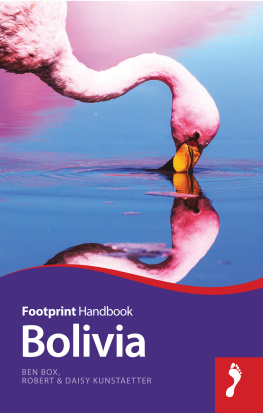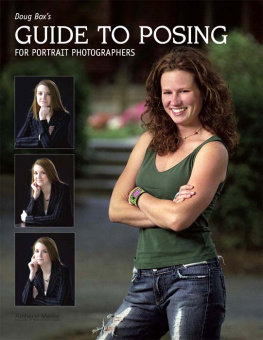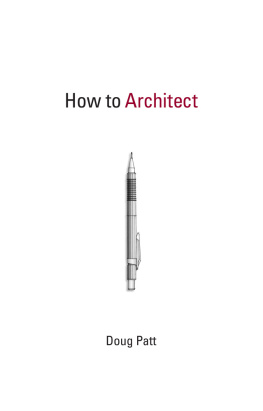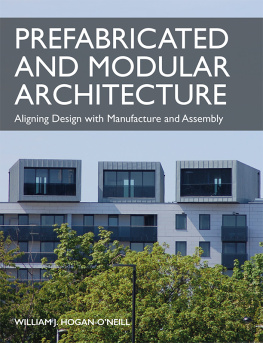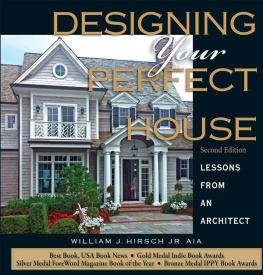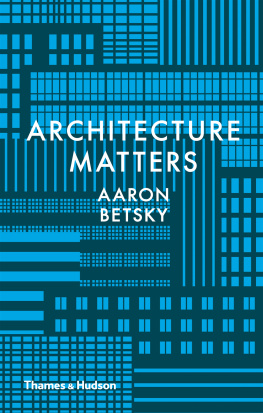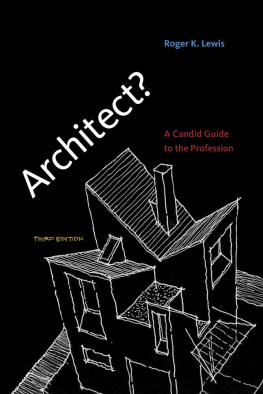Box - Think Like an Architect
Here you can read online Box - Think Like an Architect full text of the book (entire story) in english for free. Download pdf and epub, get meaning, cover and reviews about this ebook. City: Austin, year: 2007, publisher: University of Texas Press, genre: Religion. Description of the work, (preface) as well as reviews are available. Best literature library LitArk.com created for fans of good reading and offers a wide selection of genres:
Romance novel
Science fiction
Adventure
Detective
Science
History
Home and family
Prose
Art
Politics
Computer
Non-fiction
Religion
Business
Children
Humor
Choose a favorite category and find really read worthwhile books. Enjoy immersion in the world of imagination, feel the emotions of the characters or learn something new for yourself, make an fascinating discovery.

Think Like an Architect: summary, description and annotation
We offer to read an annotation, description, summary or preface (depends on what the author of the book "Think Like an Architect" wrote himself). If you haven't found the necessary information about the book — write in the comments, we will try to find it.
An award-winning architect and educator demystifies the process of making architecture and explains why good architectural design matters.
Box: author's other books
Who wrote Think Like an Architect? Find out the surname, the name of the author of the book and a list of all author's works by series.
Think Like an Architect — read online for free the complete book (whole text) full work
Below is the text of the book, divided by pages. System saving the place of the last page read, allows you to conveniently read the book "Think Like an Architect" online for free, without having to search again every time where you left off. Put a bookmark, and you can go to the page where you finished reading at any time.
Font size:
Interval:
Bookmark:
My experience in writing this book has been a delight because of the many friends who helped me. For this I give heartfelt thanks to those who came to San Miguel to lead me through this work: to Bill Wittliff for his early encouragement and coaching while sitting on a bench in the Jardin; to John Trimble for his encouragement, his kind efforts on the Roof Terrace in teaching me to write, and his dedicated e-mails of multitudes of refinements; to Betty Sue Flowers for offering her wisdom in the Portico on how to clarify and put my random thoughts together; to John McLeod for marking out the non-sense in my first draft while we were at the beach. Many thanks to my friends in Austin who gave their time and knowledge to keep me on the right track: to Anthony Alofsin for guidance and assessment of my view of history; to Michael Benedikt for years of enlarging my brain and for encouraging me in the final stages; to Eden Box, my wife of thirty years and in-house editor who would tell me when it was rotten or good; and a special thanks to Joanne and James Pratt for their careful reading and wise advice on all manner of detail and philosophy as well as for the past fifty years of working together.
And for help in the final crafting of the book at the School of Architecture, thanks to Sarah Hill, whose skillful help with the illustrations and permissions let me finish, and to Raquel Elizondo, who was always on hand to help, and to Elizabeth Schaub, of Visual Resources Collection, Charlotte Pickett, photographer, and Nancy Sparrow of the Alexander Architectural Archive. Im also grateful to those who gave me permission to use their photographs: Blake Alexander, Larry Doll, Sinclair Black, Lawrence Speck, Bill Cox, Greg Hursley, Baltazar Korab, the archives of Pratt, Box and Henderson, and especially the Visual Resource Center of the School of Architecture, University of Texas at Austin.
Many thanks to the dedicated people I worked with at the University of Texas Press, including Theresa May, who encouraged me to submit a proposal; Jim Burr, who sought to teach me how to put a book together; the readers who critiqued my early manuscript; Lawrence Kenney, who edited and helped me clarify; and Teresa Wingfield, who designed the book as you see it.
That far land we dream about, Where every man is his own Architect.
ROBERT BROWNING (18121889)
Dear Martin:
When you told us in your drawing class that we had to visit a building to appreciate it, I didnt realize that it is the actual experiencing of architecture that reveals, personally, in real time, the essence of the art. I learned that even beyond design, construction, intellectual content, and real estate value, your actual experience of the architecture is what affects your senses. And most important, your way of lifefor better or worse. True, your quality of life is largely determined by how the art of architecture and city planning have made the physical place you inhabit. The benefits of gracefulness created by design can be priceless. I cant relay to you the experience of a work of architecture in this letter, but I will describe examples of how I experienced the architecture of two special places.
Exploring central Mexico with a client in search of a site for a health spa, my wife and I were invited to see a house that might interest us because of its setting and its newly reduced price. At the end of a long day, we reluctantly turned off the main street and drove down a tree-lined drive paved with mosaic stones through an antique gate. It opened to reveal an extraordinary progression of architectural space made of carefully crafted indoor and outdoor spaces that melded the building in to, and out of, the landscape. Skillfully executed in the manner of the great Mexican modernist Luis Barragn, it was so successful that when one of the key architects of the last century, Charles Moore, walked through the house with an appraising eye, he looked back at the ethereal mass of landscape integrated with structured spaces and said, Frank Lloyd Wright, eat your heart out.
Only from the garden could you see the white stucco walls with large planes of glass dappled with light from mature flowering trees. Because the house was set in a tropical garden of green, with a sequence of fountains, ponds, and streams, it was hard to tell what was outside and what was inside. The transitions between spaces were so subtle and the openings so large that it seemed the house didnt exist; the house denied being photographed. It was all transparency with a few walls modulating the space. The purity of style in Modernism was finessed with European antiques of various provenances in a manner that seemed just right. The architecture, garden, and interiors were by the noted Mexican interior designer Arturo Pani. It was the most beautiful house we had ever seen. It was not large but engaged us more deeply than the great historical housesa magical place in the world that more than fulfilled every aspiration imaginable to us.

Transparency and ambiguity of landscape, structure, and glass. Casa Pani Cuernavaca, Mexico, 1986.
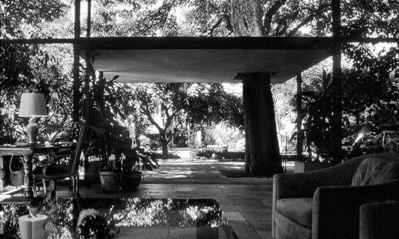
Spatial illusion from inside to outside. Casa Pani Cuernavaca, Mexico, 1986.
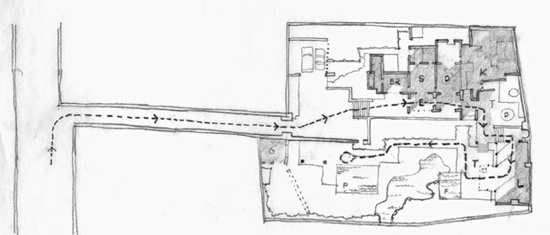
Plan of Casa Pani house and garden. Cuernavaca, Mexico, 1986.

Portion of the architectural accretion built over four hundred years. El Seor de Sacromonte, Amecameca, Mexico, 1524 onward.
On impulse, my real estate executive wife made a half-price offer to buy the house. The seller laughed at the offer, and we went away simply enjoying the deep feeling of having experienced a place of wonder. A month later, though, our offer was accepted, and a new life in a foreign country where we didnt speak the language had just begun.
Compounding the experience of this timeless Mesoamerican Spanish-Mexican culture, we drove our new Mexican car over the Paso de Cortez between the two great volcanoes in search of the sixteenth-century churches of the Spanish friars. In the village of Amecameca, where Cortez had said a mass for his small army as they moved toward the Aztecs, we sought the pilgrimage chapel of Sacromonte by spiraling up a small hill overlooking the village. This sacred place had been a cave for meditation by Fray Martn de Valencia, who arrived in 1524 as one of the first friars in the New World. As the cave became important, the village built a portico to define the entrance, and over the next three centuries the cave was expanded by sacred spaces of advancing size, chronologically growing through several styles into a hexagonal dome terminating in an unusual nineteenth-century forecourt portico. We were fascinated with this unique assemblage of time and stone.
We bought a beer and a taco from a vendor in front of the church. The cold beer and warm blue corn taco filled with sauted squash blossoms gave me a sensation that anchored me to this place. I identified with the architecture around me with such curiosity that within a few months I had formed a team of Earthwatch volunteers to document the church with measured drawings and photographsthe first of many such places in all parts of Mexico that we documented over the next twelve summers.
Font size:
Interval:
Bookmark:
Similar books «Think Like an Architect»
Look at similar books to Think Like an Architect. We have selected literature similar in name and meaning in the hope of providing readers with more options to find new, interesting, not yet read works.
Discussion, reviews of the book Think Like an Architect and just readers' own opinions. Leave your comments, write what you think about the work, its meaning or the main characters. Specify what exactly you liked and what you didn't like, and why you think so.

